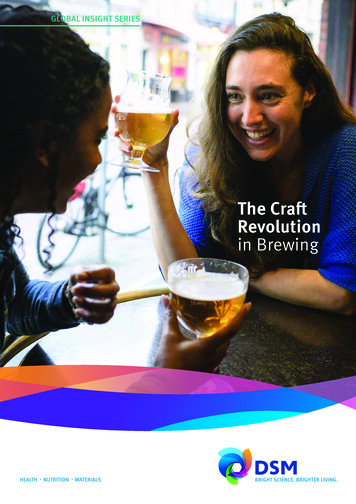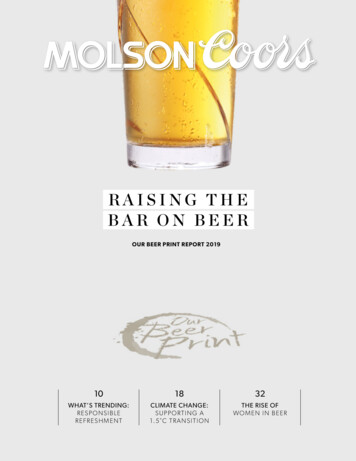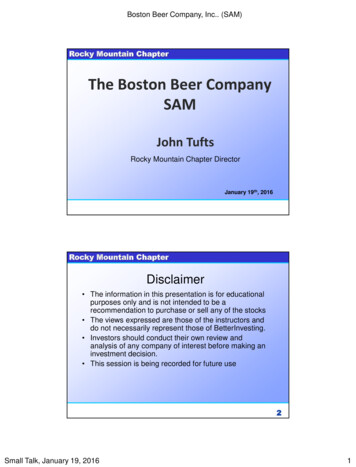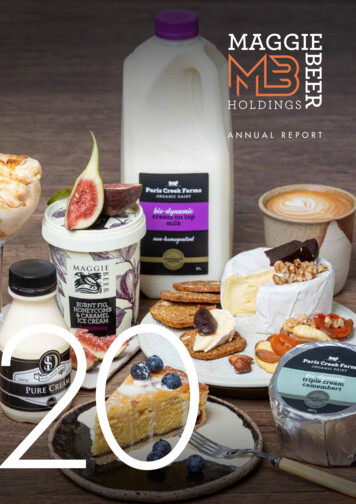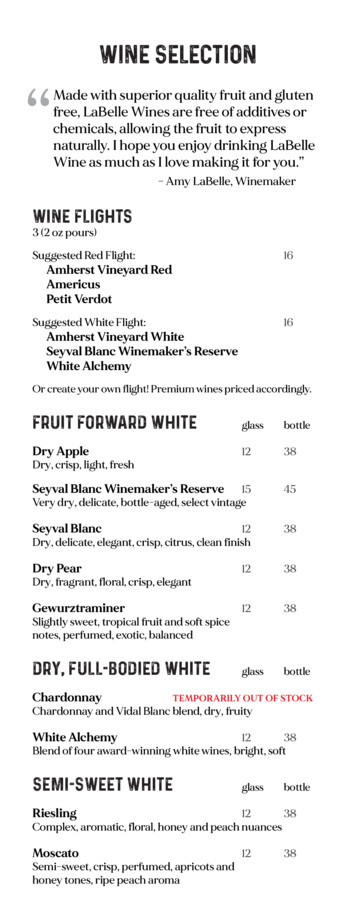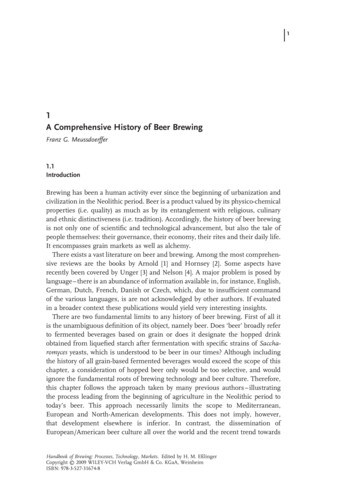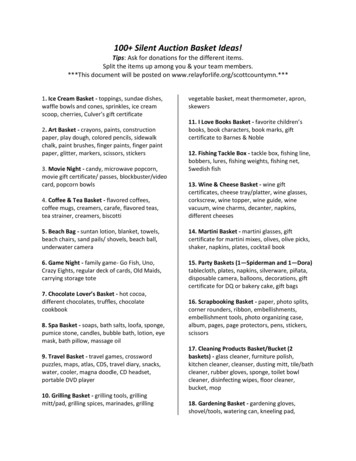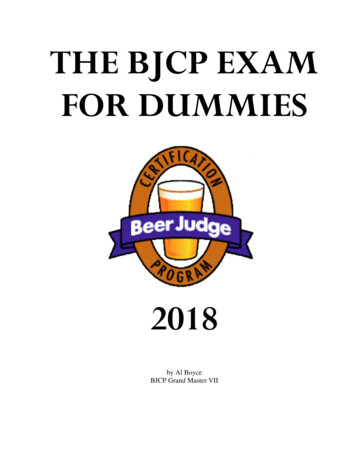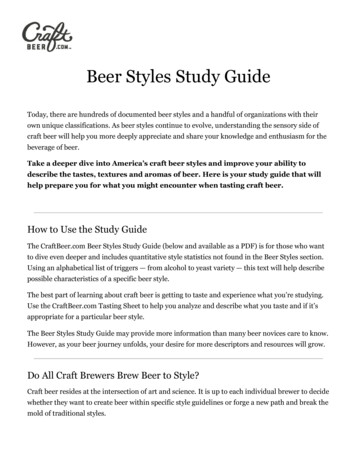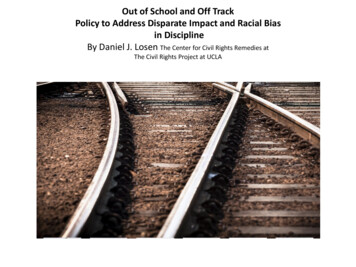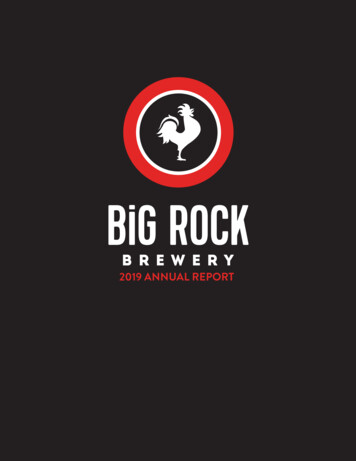
Transcription
2019 ANNUAL REPORT
FINANCIAL HIGHLIGHTSin thousands of Canadian dollars,except volumes, per share amounts and sharesSales volume (hectolitres) (1)Net revenueGross profitOperating income (loss)Net income (loss)Income (loss) per share - basic and dilutedCommon shares outstandingTotal assetsTotal debt (2)20192018171,56342,65312,336(5,100)(2,922)( 0.42)6,981,628201,57748,74820,812931360 0.056,981,62849,7826,41556,7405,775(1) Excludes contract manufacturing volumes due to the nature of the agreements.(2) Includes bank indebtedness, long term debt, and obligations under finance leases.Annual Meeting of ShareholdersThe annual meeting of Big Rock shareholders will be held:Thursday, May 14, 2020.Table of Contents24242528CEO’s MessageManagement’s Discussion and AnalysisManagement ReportIndependent Auditor's ReportFinancial Statements and NotesBig Rock Brewery Inc. - 2020 Annual Report 1
CEO’S MESSAGETo: Big Rock Shareholders2019 was a challenging year for Big Rock. Effective December 16, 2018, theformer Government of Alberta amended the provincial beer mark-up structure while eliminating the Alberta Small Brewers Development (“ASBD”)grant program. At the time, the former Government of Alberta proposed aform of financial support to Big Rock until a new permanent mark-up structure was developed. The unprecedented magnitude of the tax increase eroded a significant portion of Big Rock’s top-line revenue in Alberta with thetotal impact of this change estimated at 6.4 million for the financial yearended December 30, 2019. In May of 2019, we were advised that the newGovernment of Alberta would not implement the temporary financial reliefmeasure that was initially proposed, and instead, they would work towards anew, fair provincial mark-up structure. Within days of receiving this information, we were forced to carry out significant cost cutting measures in addition to the significant pricing changes thatwere implemented at the beginning of 2019. Together, these measures helped stabilize Big Rock’s business.Despite the underlining improvements in our business, our reported financial results reflect the difficult regu latoryenvironment Big Rock faced in Alberta in 2019. Revenue declined by 13% from 48.7 million to 42.7 million, whichwas primarily driven by the elimination of the ASBD grant program and the amended beer mark-up policy in Alberta.Sales volume declined by 15% from 202 thousand hectolitres to 172 thousand hectolitres driven by declines in ourvalue portfolio, and EBITDA(1) decreased by 5.3 million from positive EBITDA of 4.2 million (in 2018) to negativeEBITDA of 1.1 million (in 2019).Despite the challenges we faced in 2019, I am very optimistic about the future of Big Rock. Throughout thisdifficult regulatory period in Alberta, we continued to work in teams on improving our processes. We needed tolearn how to work with fewer resources and I am proud of the innovative thinking that has emerged to make ourorganization stronger. Effective September 13, 2019, the current Government of Alberta and ultimately the Alberta,Gaming, Liquor and Cannabis Commission, amended the Alberta beer mark-up policy, restoring our ability tobe competitive in the Alberta beer market. We are focused on returning to revenue growth and continue to implementprocess improvements to our marketing and sales capabilities in order to grow both sales volume and revenue (2).In 2019 we continued to demonstrate our strong commitment to innovation and quality. We successfully launched ourRock Creek Rosé Cider, Craft Lager and Jackrabbit products, and we received 11 awards including a gold Alberta Beeraward for Pilsner (Czech Style), a gold Canadian Brewing Award for Warthog and a gold CanadianInternational Beer Award for Rock Creek Rosé Cider.In 2020 we have several new innovations to release that are targeted at the fastest growing segments in ourindustry(2). We will remain focused on our mission of “All for Craft, and Craft for All” and will continuously look for thebest opportunities to grow our business while remaining focused on being Canada’s authentic craft brewery since1985(2).Sincerely,Wayne ArsenaultPresident & CEO(1) See “Non-GAAP Measures” in the Management’s Discussion and Analysis for the year ended December 30, 2019 enclosed herewith (the “MD&A”).(2) See “Forward Looking Statements” in the MD&A.Big Rock Brewery Inc. - 2020 Annual Report 2
MANAGEMENT’SDISCUSSION AND ANALYSIS
MANAGEMENT’S DISCUSSION AND ANALYSISThe following is Management’s Discussion and Analysis (“MD&A”) of the financial condition and resultsof operations of Big Rock Brewery Inc. (“Big Rock” or the “Corporation”) for the years ended December30, 2019 and 2018.This MD&A should be read in conjunction with the audited consolidated financial statements of theCorporation and accompanying notes as at and for the years ended December 30, 2019 and 2018 (the“Consolidated Financial Statements”). The Consolidated Financial Statements have been prepared usingInternational Financial Reporting Standards (“IFRS”) and all amounts are reported in thousands ofCanadian dollars unless otherwise noted. Additional information about the Corporation, including theAnnual Information Form for the year ended December 30, 2019, can be found on SEDAR atwww.sedar.com and on Big Rock’s corporate website at www.bigrockbeer.com. Readers should also readthe section “Forward-Looking Information” contained at the end of this document. This MD&A is datedMarch 13, 2020.CORPORATE PROFILEBig Rock is headquartered in Calgary, Alberta. The Corporation produces premium, all-natural craftbeers, ciders and other alcoholic beverages. As one of Canada's largest independently owned craftbrewers, Big Rock has an extensive family of permanent ales and lagers, the Rock Creek series of craftciders, a continually changing selection of seasonal and limited-edition beers and other licensed alcoholicbeverages.Founded in 1985, Big Rock was the first craft brewery in Alberta and stands as a pioneer in the Canadiancraft beer industry. Big Rock produces, markets and distributes its premium, high-quality craft beers andciders, primarily in Canada. The Corporation owns and operates production facilities in Alberta, BritishColumbia (“BC”) and Ontario. Today, Big Rock’s primary brewing, packaging and warehousing facility islocated in Calgary, Alberta and has been in operation since 1996. Big Rock has distribution facilities inCalgary and Edmonton, and sales staff resident in Alberta, BC, Saskatchewan, Manitoba and Ontario.In April 2015, Big Rock opened a brewery and eatery in Vancouver, BC’s thriving downtown craft beerdistrict. This combined brewery and brewpub serves on-premise consumers and provides distribution forBig Rock’s products throughout BC. During the fall of 2016, Big Rock opened a third brewery and tastingroom in Etobicoke, Ontario, and on February 1, 2017, a fourth location was opened in the Liberty Villagearea of Toronto, Ontario, and is operated as Liberty Commons at Big Rock Brewery tasting room andrestaurant.Given the Corporation’s footprint in Western Canada, the Corporation also has several co-packagingarrangements through private label agreements, and recently, co-manufacturing and licensingagreements.INDUSTRY TRENDS AND INDICATORSToday's beverage alcohol consumer in North America is driven by health and wellness, experience andconvenience, flavour, premiumization and value. When coupled with low barriers to entry, it has resultedin unprecedented consumer choice and blurring of categories, channels and competition in the beveragealcohol space. The Corporation believes the exponential rise in choice of craft beer over the last 5 yearsmay continue. However, Big Rock also believes that its participation in the growing Ready-to Drinkalcohol beverage (“RTD”) market is vital to the Corporation’s future success. The Corporation enteredthe RTD market in Alberta and BC in 2019 through the licensing of Cottage Springs’ products and continuesto find growth and success with the brand. Big Rock is also looking to utilize its manufacturing footprint,particularly in Calgary, to pursue new revenue streams from the RTD space, to the extent that the AlbertaGaming, Liquor and Cannabis Commission (“AGLC”) policy permits. A restrictive policy still governs theRTD market in Alberta and limits the Corporation’s ability to pursue such opportunities, which is theBig Rock Brewery Inc.Management Discussion & AnalysisPage 1 of 19Big Rock Brewery Inc. - 2020 Annual Report 4
highest growth category in alcohol, globally. Given the economic stimulus that the growing RTD marketcan provide for the province of Alberta, management is hopeful this avenue of growth will no longer berestricted very soon.2019 was a set back year for Big Rock given the AGLC beer mark-up policy imposed on the Corporationby the previous Government of Alberta, however, as previously announced, the current Government ofAlberta and ultimately the AGLC, amended such policy effective September 13, 2019 improving Big Rock’scompetitive position in the beer market. Due to the cost restructuring initiatives the Corporationundertook during the second quarter of 2019, Big Rock not only took a cultural hit, but experienced somelapses in processes that are to be expected as employees adopt new and greater responsibilities.Management believes that it has addressed such process gaps through year-end 2019 and has gainedmomentum in 2020 in re-establishing the great culture that the Corporation prided itself on since 1985.SELECTED ANNUAL FINANCIAL INFORMATIONYear Ended December 30( 000, except volumes and per share amounts)2017171,563201,577208,565 42,653 48,748 46,5734,1501,907Sales Volumes (hl)Statements of Comprehensive Income DataNet revenue20182019(1)EBITDA(2)(1,062)Operating profit (loss)(5,100)931(1,037)Net income (loss)(2,922)360(1,020)Per share – basic and diluted (0.42) 0.05 (0.15)Statements of Financial Position DataTotal assets49,78256,74053,481(3)6,4155,7756,416Total debt(1)(2)(3)Excludes contract manufacturing volumes due to the nature of the agreements.Earnings Before Interest, Tax, Depreciation and Amortization (“EBITDA”). See “Non-GAAP Measures”.Includes bank indebtedness, long term debt, and obligations under finance leases.SELECTED QUARTERLY FINANCIAL INFORMATIONBig Rock experiences seasonal fluctuations in volumes, net sales revenue and net income with the secondand third quarters typically being stronger than the first and fourth quarters. These seasonal variationsare dependent on numerous factors, including weather, timing of community events, consumerbehaviour, customer activity and overall industry dynamics, mainly in Western Canada. Additionally,significant fluctuations in the AGLC beer mark-up policy over the last six years has caused significantvariation in the impact of provincial government liquor tax programs on net revenue. The selectedquarterly information is consistent with these expectations and industry trends.The following is a summary of selected financial information of the Corporation for the last eightcompleted quarters:Big Rock Brewery Inc.Management Discussion & AnalysisPage Report2 of 19 Big Rock Brewery Inc. - 2020 Annual5
2019( 000, except hl and pershare amounts)Sales volumes (hl)(1)Net 631,246Operating profit (loss)(1,615)(761)(495)(2,229)216747473(505)Net income (loss)Earnings per share (basicand diluted) Per hl Amounts(1)(1,297)(201)297(1,721)(80)587240(387) (0.19) (0.03)0.04 (0.25) (0.01)Net revenue255.32222.33271.96246.63244.65Cost of 83.66(645) 0.080.04 4865.7276.3528.8830.0828.558.46(12.40)Selling expensesGeneral andadministrativeOperating profit 2)(63.73)4.4113.40Net income (loss)(34.71)(3.99)6.07(49.21)(1.63)10.53(1)(2) 2664.30(9.51)Excludes contract manufacturing volumes due to the nature of the agreements.See “Non-GAAP Measures”.RESULTS OF OPERATIONSBig Rock reported net loss of 2,922 for the year ended December 30, 2019, compared to net income of 360 in 2018. The net loss is due to the then Government of Alberta’s elimination of the Alberta SmallBrewers Development (“ASBD”) grant in late 2018. Management estimates the net negative impact ofthe late 2018 Alberta beer mark-up changes to be approximately 6.4 million for the year.The Corporation experienced significant sales volume declines in the fourth quarter of 2019 as comparedto the fourth quarter of 2018, driven by major declines in private label and value brands as a result ofthe price increases taken earlier in the year and potentiated by the strategic pricing initiative taken bythe Corporation in December 2018 to maximize sales volumes while the ASBD grant program remained inplace. Additionally, the Corporation experienced significant inventory revaluation and write-offs inaddition to lower than anticipated production volumes in the fourth quarter of 2019 as the Corporationfocused on inventory clean-up initiatives to position itself for a stronger 2020.As previously announced, the Corporation implemented significant cost cutting measures in the secondquarter of 2019 and restructuring charges to mitigate its operating losses incurred in the difficultregulatory environment in Alberta at the time. Effective September 13, 2019, the Corporation’s Albertabeer tax rate was reduced to 0.64 per litre which is a 4 percent increase to the net rate (adjusted forthe ASBD grant) that the Corporation was subject to in late 2018, before the elimination of the ASBDgrant program. Management believes this revised AGLC beer mark-up policy allows for the evaluationand pursuit of profitable and sustainable growth within the beer category until the end of the currentAlberta Government’s term; however, Big Rock will continue to be proactive with the Government ofAlberta moving forward.SEGMENTED INFORMATIONBig Rock has two reportable business segments, wholesale and retail, which are monitored by executivemanagement for purposes of making decisions about resource allocation and performance management.The wholesale segment manufactures and distributes beer and cider to provincial liquor boards, groceryBig Rock Brewery Inc.Management Discussion & AnalysisPage 3 of 19Big Rock Brewery Inc. - 2020 Annual Report 6
chains, and on-premise customers which is subsequently sold to end consumers. The retail segment sellsbeverages, food and merchandise to end consumers through premises owned and/or operated by theCorporation.Segment performance is evaluated on a number of measures, the most significant being gross profit netof selling expenses. Transfer prices between operating segments are on an arm’s length basis in a mannersimilar to transactions with third parties. The Corporation’s operating assets and liabilities, general andadministrative expenses, income taxes and capital expenditures are managed on a corporate basis.SEGMENTED RESULTSFor the year ended December 30Wholesale20192018Net Revenue 40,851Cost of sales28,156Gross profit (loss)12,695Selling expenses11,336Segment profit (loss) 1,359General and administrative costsDepreciation and amortizationOperating profit (loss)Finance expenseOther income )(Loss) income before income taxes 47,144 25,35121,79313,537 8,256 192018 2,245 3,226(981)25 (1,006) (551)(551)——— Consolidated20192018(641)(641)——— 42,65330,31712,33611,3479895,556533(5,100)401713 (4,788) 48,74827,93620,81213,5627,2505,79552493132718 622Net RevenueNet revenue includes wholesale beer, cider and alcoholic beverage sales, net of excise taxes andprovincial government liquor taxes, contract manufacturing revenues, retail restaurant and store salesfrom Big Rock’s Alberta, BC and Ontario locations and can sourcing for a third party. Geographically,Alberta continued to represent the largest share of the Corporation’s sales in 2019, followed by BC andOntario.Year ended December 30( 000, except volumes)Sales volumes (hl)(1)Gross revenue Federal excise taxesProvincial liquor tax programsNet revenue20192018Change171,563201,577(30,014) (1,867)65,116 66,983(5,443)(6,003)(17,020)(12,232)560(4,788) 42,653 48,748 46,503 (6,095)(6,203)Net revenue by segmentWholesaleRetailNet revenue40,3002,353 42,6532,245 48,748108 (6,095) per hl(1)Wholesale net revenue234.90230.704.20(1) Excludes contract manufacturing volumes due to the nature of the agreements.Big Rock Brewery Inc.Management Discussion & AnalysisPage 4 of 19Big Rock Brewery Inc. - 2020 Annual Report 7
Sales volumes were 171,563 hl for the year ended December 30, 2019, which represents a decrease of30,014 hl (14.9%), compared to the prior year primarily due to major price increases to Big Rock’sproducts taken at the beginning of 2019 in response to the elimination of the ASBD grant program, inaddition to the declining beer consumption and increased competition, particularly in Alberta.Additionally, this significant year-over-year decline was potentiated by the strategic pricing initiativesand resulting sales volume maximization outcome achieved in December 2018.Gross revenue was 65,116 for the year ended December 30, 2019, a decrease of 1,867 (2.8%) comparedto the prior year. Federal excise taxes decreased for the year ended December 30, 2019, due to theoverall decline in production as a result of the decline in sales. Provincial liquor taxes increased by 4,788in fiscal 2019, compared to the prior year as a result of the elimination of the ASBD grant program and asignificant decline in sales volume. As a result, net revenue was 42,653 for the year ended December30, 2019, which represents a decrease of 6,095 (12.5%) as compared to fiscal 2018.Wholesale RevenueWholesale net revenue decreased by 6,203 (13.3%) due to sales volumes decreasing by 30,014 hl (14.9%),for the year ended December 30, 2019, as compared to the prior year. Due to the elimination of theASBD grant program and the subsequent increase in the net Alberta beer taxes applicable to theCorporation, the Corporation was forced to pursue major price increases in late 2018 and early 2019,especially on low margin, high volume brands, resulting in greater than forecasted sales volume declinesyear-over-year. Contract manufacturing production volumes continued to grow year-over-year andpartially mitigated the sales volume declines resulting from the Corporation’s price increases in early2019.Retail RevenueRetail net revenue increased by 108 (4.8%) for the year ended December 30, 2019 compared to thesame period in 2018, primarily reflecting the Calgary retail operations performance and revenue drivenby Big Rock branded events.Cost of SalesCost of sales was 30,317 for fiscal 2019, an increase of 2,381 from fiscal 2018. Cost of sales represented71.1% of net revenue in 2019, an increase of 13.8% from 57.3% in 2018. This is due to net revenue declinesas a result of the elimination of the ASBD grant program and the addition of a lower margin business insourcing cans for a third party. Despite the fourth quarter of 2019 being highlighted by inventory andcost of sales revaluations and inventory write-offs, management anticipates cost of sales as a percentageof revenue to trend down in 2020 as a result of the AGLC beer mark-up policy amendment effectiveSeptember 13, 2019.Selling ExpensesSelling expenses decreased for the year ended December 30, 2019 by 2,215 to 11,347, as comparedwith the same period last year, due to the following: delivery and distribution costs decreased by 257 due to lower sales volumes; salaries and benefits costs decreased by 637, as a result of cost cutting initiatives implementedduring the second quarter of 2019; and marketing and sales costs decreased by 1,321 as a result of cost cutting initiatives implementedduring the second quarter of 2019.Big Rock Brewery Inc.Management Discussion & AnalysisPage Report5 of 19 Big Rock Brewery Inc. - 2020 Annual8
General and Administrative ExpensesGeneral and administrative expenses decreased by 239 to 5,556 for the year ended December 30, 2019,as compared with the same period last year, primarily due to a decrease in salaries and wages of 643and banking fees of 60, offset by restructuring charges of 476.General and administrative expenses were 13.0% of net revenue in fiscal 2019, versus 11.9% in fiscal 2018as a result of the significant impact of the AGLC beer mark-up increase in Alberta through much of 2019.Finance ExpensesFinance expenses increased in fiscal 2019 by 74 to 401, relative to fiscal 2018, due to servicing of thelicense obligation of the Fireweed Transaction (as defined herein) with Fireweed Brewing Corp.(“Fireweed”) and an increase in the Corporation’s total debt outstanding.Depreciation and AmortizationDepreciation and amortization expenses were 533 in fiscal 2019, versus 524 in fiscal 2018. The increasein depreciation and amortization in 2019 is primarily related to the acquisition of certain Fireweed assetsin the fourth quarter of 2018.Other IncomeOther income was 713 in fiscal 2019, compared to an expense of 18 in fiscal 2018, due to a one-timegain from the reduction of the Fireweed license obligation as a result of the impaired receivable andpenalty settlement. Refer to Cash Flows from Financing Activities for further detail.Income TaxesCurrent income tax expense of 90 and a deferred tax recovery of 1,956 was recorded for the yearended December 30, 2019. The deferred income tax provision differs from the statutory rate of 26.57%(2018 – 27.07%) due to permanent differences between the carrying amounts of assets and liabilities foraccounting purposes and the tax basis, as well as the effect of non-deductible amounts.Big Rock Brewery Inc.Management Discussion & AnalysisPage 6 of 19Big Rock Brewery Inc. - 2020 Annual Report 9
FINANCIAL CONDITIONThe following chart highlights significant changes in the Consolidated Statements of Financial Positionfrom December 30, 2018 to December 30, 2019:Increase/(Decrease)( 000, unless otherwise stated)Primary factors explaining changeAccounts receivable(1,739)Decrease due to grants receivable and other customeramountsInventories(1,241)Decrease in finished goods due to timing of productionschedule, seasonality and revaluationPrepaid expenses & deposits(53)Current income taxes(176)Property, plant and equipmentAccounts payable & accrued liabilitiesDecrease due to reduction in expected taxable income(2,290)Decrease due to depreciation offset by new plantadditions(87)Decrease due to amortization of intangible assetsIntangible assetsBank indebtednessDecrease in community sponsorship due to timing of plannedevents1,369Increase in the combined balances of the Operating Facilitybalance and outstanding cheques(1,633)Decrease consistent with the decrease in inventories relatedto seasonalityShare-based payments(130)New long term incentive grants offset by decrease in shareprice and former employee forfeiture of share appreciationrightsLong term debt & finance lease(729)Net repayment of term loans and finance leasesLicense obligation(1,025)Lease incentive27Deferred income taxes(1,956)Net repayment of license obligation and settlement of BCLiquor Distribution Branch/Fireweed receivable amountsAmortization of lease incentiveTax effect of changes in temporary differencesLIQUIDITY AND CAPITAL RESOURCESCapitalizationAs at December 30,( 000, unless otherwise stated)Cash Total debt(2)(1)Net debt2019(354) 2018(1,902)6,4155,7756,0613,873Shareholders’ equity:113,845113,845Contributed surplus1,7951,578Accumulated deficit(79,761)(76,839)35,87938,584Shareholders’ capitalTotal shareholders’ equityTotal capitalization (total debt plusshareholders’ equity, net of cash) (1)Net debt to capitalization ratio (1)(1)(2) 41,94014.5% 42,4579.1%See “Non-GAAP Measures”.Includes bank indebtedness, long term debt, and obligations under finance leases.Big Rock Brewery Inc.Management Discussion &BigAnalysisPage7 of 19 Rock Brewery Inc. - 2020 AnnualReport10
Capital StrategyThe Corporation defines its capital to include common shares of the Corporation ("Common Shares") plusshort-term and long-term debt and finance leases, less cash balances. There are no externally imposedcapital requirements on the Corporation. The Corporation’s objectives are to safeguard the Corporation’sability to continue as a going concern, to support the Corporation’s normal operating requirements andto maintain a flexible capital structure which optimizes the costs of capital at an acceptable risk. Thisallows management to maximize the profitability of its existing assets, create long-term value andenhance returns for its shareholders.The Corporation manages its capital structure through prudent levels of borrowing, cash-flow forecasting,and working capital management. Adjustments are made by considering changes in economic conditionsand the risk characteristics of the underlying assets. To maintain or adjust the Corporation’s capitalstructure, Big Rock may issue new shares, issue or renegotiate its debt, acquire or dispose of assets oradjust the amount of cash and cash equivalents. Capital requirements of the Corporation are managedby the preparation of an annual expenditure budget which is approved by the board of directors of BigRock (the “Board of Directors”) and monitored on a regular basis by management. The budget is updatedas necessary depending on numerous factors, including capital deployment, results from operations,general industry conditions and government policy changes.The Corporation had a positive working capital position of 419 at December 30, 2019, compared to 4,557 at December 30, 2018.As at December 30, 2019, the Corporation had total current assets and total current liabilities of 6,597and 6,178, respectively, compared to 11,178 and 6,621, respectively, as at December 30, 2018. Thedecrease in current assets can be attributed to a decrease in the cash balances as a result of thesignificant decrease in the Corporation's margins for much of 2019 due to the AGLC beer mark-up increasein addition to the settlement of the Fireweed receivable balances. The increase in current liabilities canbe attributed to an increase in the Corporation’s bank indebtedness.The Corporation may issue new Common Shares, debt or other securities, acquire or dispose of assets oradjust the amount of cash and cash equivalents to maintain or adjust its capital structure. Big Rockmanagement prepares annual expenditure budgets, which are approved by the Board of Directors, tofacilitate management of its capital requirements. These budgets are updated as necessary dependingon numerous factors, including capital deployment, results from operations, general industry conditions,and government policy changes.Additionally, the Corporation monitors its capital using ratios of (i) net debt (debt less cash) to EBITDAand (ii) EBITDA to interest, debt repayments and dividends. Net debt to EBITDA is calculated by dividingnet debt by EBITDA. EBITDA to interest, debt repayments and dividends is calculated by dividing EBITDAby the combined interest, debt repayments and dividend amounts. These capital management policies,which remain unchanged from prior periods, provide Big Rock with access to capital at a reasonable cost.The calculation of EBITDA is a non-GAAP measure, whose nearest GAAP measure is net income, or netloss as applicable, with the reconciliation between the two as follows:Year ended December 302019( 000, except volumes)Net income (loss) (2,922)2018 360Change (3,282)Addback:Interest401TaxesDepreciation and amortization 1 4,150124 (5,212)Non-GAAP measure. See “Non-GAAP Measures”.Big Rock Brewery Inc.Management Discussion & AnalysisPage 8 of 19Big Rock Brewery Inc. - 2020 Annual Report 11
Cash Flow from Operating ActivitiesCash used in operating activities for the year ended December 30, 2019 totalled 1,218, a decrease of 5,826 compared to the prior year. The decrease is primarily due to the elimination of the ASBD grantprogram in Alberta.Cash Flow from Financing ActivitiesCash provided by financing activities for the year ended December 30, 2019 increased by 1,276compared to 2018, as the Corporation increased bank indebtedness which includes outstanding cheques.The Corporation has a 5 million revolving operating loan facility (the “Operating Facility”) and a 6million 5-year revolving term loan facility (the “Term Facility”). The Operating Facility is available forgeneral operating purposes and funding capital expenditure requirements. The Term Facility is availableto fund capital expenditures. Advances under both credit facilities may be made by way of Canadianprime rate loans and letters of credit. Interest is payable for prime-based loans under the OperatingFacility at the financial institution’s prime rate plus 0.75 percent and for the Term Facility at thefinancial institution’s prime rate plus 1.5 percent. Fees for letters of credit are at 2.5 percent with aminimum fee payable.The facilities impose a number of positive and negative covenants on Big Rock, including the maintenanceof certain financial covenants which are tested at each reporting date. They include the maintenance ofa rolling 12-month fixed charge ratio which is required to be a minimum of 1.1 to 1, calculated as therolling 12-month EBITDA, less an amount for maintenance capital compared to the rolling 12-monthsFixed Charges. In addition, Big Rock’s borrowings cannot exceed a borrowing base which is determinedby the fair value of the Corporation’s assets. On August 1, 2019, Big Rock’s lender waived the financialcovenants under its credit facilities until and including June 30, 2020. Should the
The annual meeting of Big Rock shareholders will be held: Thursday, May 14, 2020. Annual Meeting of Shareholders. 2 4. 24 25. 28. Table of Contents. CEO's Message Management's Discussion and Analysis Management Report Independent Auditor's Report Financial Statements and Notes in thousands of Canadian dollars,
